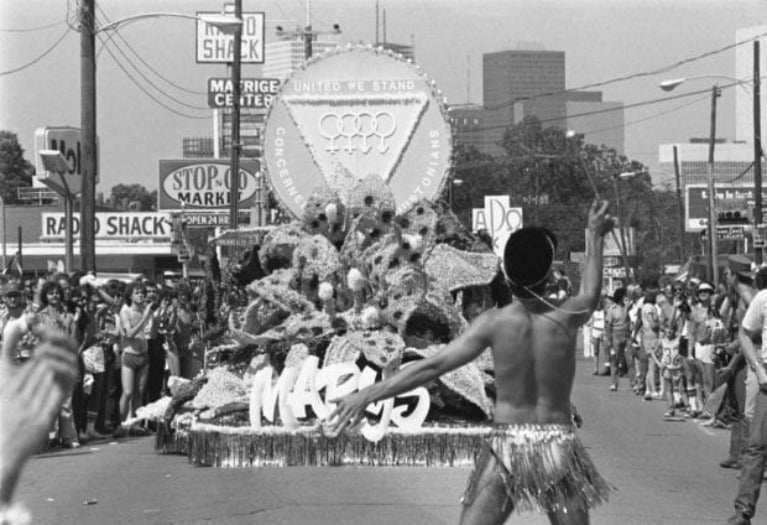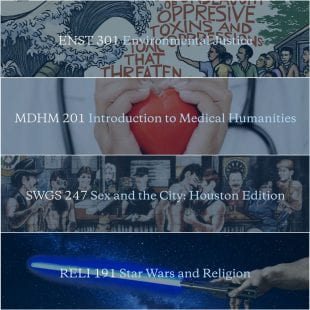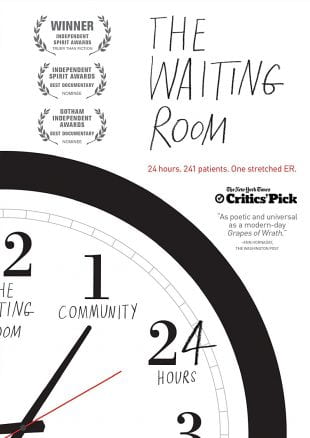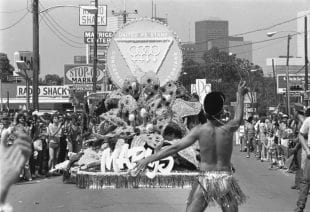For the second year in a row, Rice is offering summer courses through its Visiting Owl program that provide high school and visiting college students the opportunity to learn online alongside current Rice students — while earning credit.
In the School of Humanities, look for unique topics and returning favorites among the summer catalog, including two popular courses always waitlisted in spring and fall as student interest in the minor tracks has spiked in recent years: Introduction to Medical Humanities (MDHM 201) and Environmental Justice (ENST 301).
“We are very excited about our new summer session courses, which include some of the core and classic Humanities courses, along with new courses that invite students into some of our most popular interdisciplinary programs and minors, such as Latin American studies, medical humanities and environmental humanities,” said Dean of Humanities Kathleen Canning.
Environmental studies classes have been welcomed with surging demand both across the nation and at Rice, while enrollment in Rice’s Medical Humanities minor has sharply increased every year since it was launched in 2016. The McGovern Medical School Partnership also continues to provide humanities majors with a facilitated pathway to the University of Texas McGovern Medical School, a unique program among Rice’s peer institutions.
“I think the Medical Humanities Program is so popular because it stemmed from student interest," said Melissa Bailar, director of grants and initiatives in the Humanities Research Center and adjunct lecturer of humanities, who’s teaching Intro to Medical Humanities once again this summer.
Bailar’s seven-week summer session features a host of guest speakers that includes those in healthcare professions and the humanities is ideal for exploring the Medical Humanities program at Rice.
Assignments include readings and documentaries, with one class a week that’s asynchronous and allows students time for in-depth conversations about such topics as gender identity and health care via private classroom discussion boards.
“Med schools have started really looking for students with some sort of humanities background,” Bailar said. “They want to see good communication skills, cultural awareness, and an understanding of the social determinants of health — things that you don't necessarily learn in other classes.”
The Environmental Studies minor is jointly housed in the schools of Architecture and Humanities and works closely with the Environmental Science program in the School of Natural Sciences. As such, it draws a wide cross-section of students from all majors. This is particularly true in Environmental Justice, said Gisela Heffes, associate professor of Latin American literature and culture who’s also returning to teach a summer version of the course.
“You have students coming from the natural sciences, from the social sciences, and from the Humanities, especially from English and history — just a very broad spectrum,” Heffes said. The course offers both concrete case studies of unequal distributions of environmental risks — such as the effects of mining, sea level rise or toxic waste deployed in close proximity to a community, for instance — but it also examines environmental inequality and disproportional injustice through the lens of literature, poetry, art exhibitions and installations, and films and documentaries.
“Often, students have not been in contact with narratives that offer a perspective of the situation from an angle that may be completely different from a case study,” said Heffes, who just published “The Latin American Ecocultural Reader,” a collection of seminal Latin American writing on the environment.
Reading novels and situating themselves in characters’ experiences — like, say, those characters living in a landfill in Costa Rica in “Unica Looking at the Sea” — allows students to develop a new sense of empathy, she said. The course also seeks to help students consider solutions to the problems they encounter while broadening their understanding of just how truly interconnected our world is.
Students interested in humanities research and scholarship will be fascinated by Sex and the City: Houston Edition (SWGS 247), which will delve into historical documents to uncover how the regulation of such areas as sex work and pornography has shaped the geography of our city.
How does a famously anti-zoning city like Houston end up with red light districts or “gayborhoods”? And how do battles over facilities such as reproductive care clinics impact specific urban spaces?
“Look at how regulation of sexuality has actually shown up in concrete forms, whether it’s a building like an adult bookstore or the structure of a neighborhood in its economic layering: Who was able to afford housing there and why?” said Brian Riedel, associate director of Rice’s Center for the Study of Women, Gender and Sexuality, who’s teaching this brand-new course. “And how did those things end up in turn actually affecting our own sexualities?”
The course dovetails with an ongoing book project, which has found Riedel deep in the city archives reviewing deeds and property sales as he plots the migration of people and businesses in Houston’s ever-shifting neighborhoods — in particular Montrose, which has been at various points in its history an elite, heterosexual suburb, an urban enclave for LGBTQ+ communities and, now, a bobo paradise.
Matthew Dillon is teaching two courses this summer: Introduction to the Study of Religion (RELI 101), a popular survey course, and Star Wars and Religion (RELI 191), a course all his own. As a graduate of Rice’s religion department (the postdoc received his Ph.D. in 2017) and a devoted “Star Wars” fan (who previously had a shrine in his office), he’s uniquely suited to both.
Unlike biology or English, Dillon said, students are rarely exposed to religious studies in high school, so the course lays out how religion is analyzed from a secular and academic perspective. Four traditional religions — Judaism, Christianity, Hinduism and Buddhism — are examined in their historical contexts and how they’ve been adapted in a modern American context.
“For instance, we'll look at the three main historical forms of Buddhism — Theravada, Mahayana, Vajrayana — and then at how Buddhist practices like ‘mindfulness’ meditation and beliefs such as reincarnation are shifting in the American context,” Dillon said. Similarly, they’ll also delve into Black Lives Matter and its relation to the Black church in America.
Dillon previously taught at DePauw University, where his “Star Wars” course was always waitlisted.
“‘Star Wars’ contains all the elements of a mythology,” Dillon said. “Like the Mahabharata or Exodus, it exhibits grand cosmic and political events through the eyes of a few pivotal persons. It is the product of many, many, many authors, across time and place.”
At the same time, he said, it’s a product of its own historical context, including the wars in Vietnam and Iraq and the space race. As such, humanities scholars can and do use all the tools they would in analyzing a traditional mythological system. Students will definitely come away from the course with the ability to win “any ‘Star Wars’ trivia night,” Dillon said, but they’ll also have the opportunity to apply these theories and methods.
“But most importantly, I hope the course gives students the tools to meaningfully and critically engage products of their lived world long after the course has ended,” he said.
Other core courses this summer include the study of ethics, morals and values, an introduction to European history, a survey of literature and the environment, another on literature and medicine, an introduction to fiction writing and a history of 19th century art. And among other brand-new offerings are a history of feminism and a look at 20th century German history through film.
“We are happy to include this year a newly featured course on the history of voting rights in America as well as returning courses on 'How to Read Texts,' a survey of American film and another course on the history of the Western film genre,” Canning said.
“Nearly every one of our departments and programs participates in Summer Session as well as some of our leading faculty members,” she said. “We are thrilled to offer students such a wide range of course offerings.”






